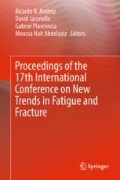Abstract
In this work the analysis for the determination of the mechanism of failure by SCC of two tees located in different places of a system of pressurized drainage is shown. Being independent elements of the same system, tests were performed in both cases: visual inspection, chemical analysis, mechanical tests, metallographic examination and fractographic examination. The visual inspection established that in both pieces the fracture is located in the direction perpendicular with respect to the straight side, where a steps in the area of the fracture is observed. The corrosion products were characterized by oxides and iron sulphides by means of an Energy Dispersive Spectroscopy (E.D.S). The corrosion products were formed by the presence of H2S and H2O. In addition, the presence of diffused hydrogen was verified by the immersion in glycerin at 60 °C, in the materials of failure. In both cases, the evolution of hydrogen at the fracture surface was detected by the presence of bubbles. It was determined that the failure mechanism in both cases was corrosion cracking under stress in the presence of hydrogen.
Access this chapter
Tax calculation will be finalised at checkout
Purchases are for personal use only
References
ASTM E 2332-04 “Standard Practice for Investigation and Analysis of Physical Component Failures”.
ASTM E 18-17 “Standard Test Methods for Rockwell Hardness of Metallic Materials”.
ASTM E3-11 (2017) “Standard Guide for Preparation of Metallographic Specimens”.
González Velázquez Jorge Luis (2013), Mecánica de la Fractura, México D.F., Limusa Noriega.
ASTM E-1245 (2016), Standard practice for determining the inclusions or second-phase constituent content of metals by automatic image analysis.
ASTM E-45 (2013), Standard Test Methods for Determining the Inclusion Content of Steel.
ASTM E-1382 (2015), Standard test method for determining average grain size using semiautomatic and automatic image analysis.
González Velázquez Jorge Luis (1999), Metalurgia Mecánica, México D.F., Limusa Noriega, ISBN 968-18-5782-8.
Author information
Authors and Affiliations
Corresponding author
Editor information
Editors and Affiliations
Rights and permissions
Copyright information
© 2018 Springer International Publishing AG
About this paper
Cite this paper
Rivas, D., González, J.L., Casarrubias, A., Beltran, M. (2018). Failure Analysis of Stress Corrosion Cracking of Two Tees in a Pressurized Drainage System. In: Ambriz, R., Jaramillo, D., Plascencia, G., Nait Abdelaziz, M. (eds) Proceedings of the 17th International Conference on New Trends in Fatigue and Fracture. NT2F 2017. Springer, Cham. https://doi.org/10.1007/978-3-319-70365-7_35
Download citation
DOI: https://doi.org/10.1007/978-3-319-70365-7_35
Published:
Publisher Name: Springer, Cham
Print ISBN: 978-3-319-70364-0
Online ISBN: 978-3-319-70365-7
eBook Packages: Chemistry and Materials ScienceChemistry and Material Science (R0)

